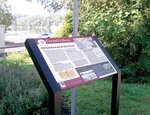


Before there was a town named Lambertville, there was Coryell’s Ferry, one of the first ferries to operate on the Delaware River. Established in 1733, the ferry served as a vital link on Old York Road, one of Colonial America’s first regional roads, which connected the colonies’ two largest cities, Philadelphia and New York.
As one of the area’s first settlers, Emanuel Coryell bought the rights to a ferry service and nearby land in 1732. Nearly a year later, Emanuel obtained a license from the colonial governor “for the sole liberty and privilege of using and keeping a ferry.”
When Emanuel died in 1749 at age 43, his first son Abraham inherited the ferry. In 1764, his younger son John bought the ferry service on the Pennsylvania side. Because the Coryells owned and operated ferries at the important Old York Road crossing for more than 60 years, Coryell’s Ferry became the first place-name for what is now Lambertville.
Coryell’s Ferry also played a pivotal role during the Revolutionary War when General George Washington chose to take Old York Road to Coryell’s Ferry to pursue the British army heading from Philadelphia to New York. Of course, Washington’s most famous crossing of the Delaware occurred at a site seven miles south of Coryell’s Ferry on Dec. 25, 1776, prior to the Battle of Trenton. Lesser known but on a far grander scale was the crossing of Washington’s army at Coryell’s Ferry en route to the Battle of Monmouth. In late June 1778, the Continental Army left its winter quarters at Valley Forge to march across New Jersey in pursuit of the British army as it headed from Philadelphia toward Monmouth Court House (near Freehold). At Coryell’s Ferry, Washington’s army executed a monumental, multi-day ferry crossing of close to 1,300 horses, some 300 wagons and 32 cannon. More than 10,000 soldiers also crossed in Durham or similar flat-bottomed boats.
After crossing the Delaware, Washington wrote to Henry Laurens, President of the Continental Congress, as follows: “Head Qrs near Coryel’s, June 22, 1778: I have the honor to inform you that I am now in Jersey and that the Troops are passing the river at Coryel’s; and are mostly over.”
Aside from its value to the Revolutionary War effort, Coryell’s Ferry was one of the most important crossing points of the Delaware River in the 18th century, especially for travel between New York and Philadelphia.
The strategic location of Coryell’s Ferry in colonial America promoted travel and contributed to the development of Lambertville and numerous other towns along the well-traveled Old York Road.
When stagecoach service was introduced between the colonies’ two largest cities in 1769, travel on Old York Road became even more popular and the ferries had a new conveyance to transport besides horses and wagons.
In 1814 a new wooden bridge over the Delaware at Coryell’s Ferry put the two ferries out of business. The passing of the ferries, the construction of a new inn, and establishment of a new post office at the inn led to the re-naming of the town.
Captain John Lambert, from a family of early settlers in the area, saw the new bridge as a business opportunity and built a stone inn circa 1812 about the time bridge construction began. (The inn is now the much-enlarged Lambertville House on Bridge Street.)
Captain Lambert’s uncle — Senator John Lambert — was instrumental in locating a post office at the inn and in the appointment of his nephew as postmaster in 1814. As the new postmaster, Captain Lambert was in a position to rename the town “Lambert’s Ville” in 1814, although the U.S. Post Office did not officially acknowledge the change until 10 years later. When the town was incorporated in 1849, the “s” in the name was dropped to become Lambertville.
The Coryells in town were not happy with the renaming, referring to it as “Lambert’s villainy.” In an effort to carry on their family’s legacy, they advocated unsuccessfully to name the town “Georgetown” after Revolutionary War veteran Captain George Coryell.
Today, the Coryell name survives on Coryell Street, where the Coryells laid out lots in the early 1800s, leading to further development of the town.
All that remains to commemorate Coryell’s Ferry is Ferry Street, where the ferry was located and where the Coryells first lived and operated their inn.
Tom Ogren is a Lambertville Historical Society board member.
“Heralding Our History” is a weekly feature. Each month, the Herald delves into the history of one of its towns.
Join our readers whose generous donations are making it possible for you to read our news coverage. Help keep local journalism alive and our community strong. Donate today.